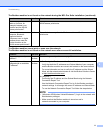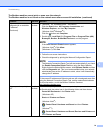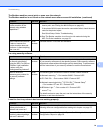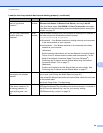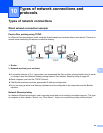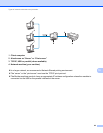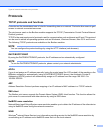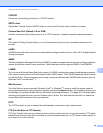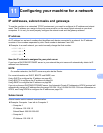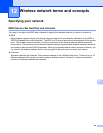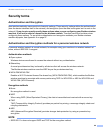
Types of network connections and protocols
85
10
LPR/LPD 10
Commonly used printing protocols on a TCP/IP network.
SMTP client 10
Simple Mail Transfer Protocol (SMTP) client is used to send E-mails via the Internet or Intranet.
Custom Raw Port (Default is Port 9100) 10
Another commonly used printing protocol on a TCP/IP network. It enables interactive data transmission.
IPP 10
The Internet Printing Protocol allows you to print documents directly to any accessible machine via the
internet.
mDNS 10
mDNS allows the Brother print server to automatically configure itself to work in a Mac OS X Simple Network
Configured system.
SNMP 10
The Simple Network Management Protocol (SNMP) is used to manage network devices including computers,
routers and Brother network ready machines. The Brother print server supports SNMPv1 and SNMPv2.
LLMNR 10
The Link-Local Multicast Name Resolution protocol (LLMNR) resolves the names of neighboring computers,
if the network does not have a Domain Name System (DNS) server. The LLMNR Responder function works
in both the IPv4 or IPv6 environment when using a computer that has the LLMNR Sender function such as
Windows Vista
®
and Windows
®
7.
Web Services 10
The Web Services protocol enables Windows Vista
®
or Windows
®
7 users to install the drivers used for
printing and scanning by right-clicking the machine icon from the Network folder. (See Installing drivers used
for printing and scanning via Web Services (Windows Vista
®
and Windows
®
7) on page 93.) For details about
scanning using Web Services, see the Software User’s Guide. The Web Services also lets you check the
current status of the machine from your computer.
HTTP 10
The HTTP protocol is used to transmit the data between a web server and a web browser.
FTP (For the Scan to FTP feature) 10
FTP (File Transfer Protocol) is a network protocol used to transfer files from one host to another. FTP allows
the Brother machine to scan black and white or color documents directly to an FTP server located locally on
your network or on the internet.



